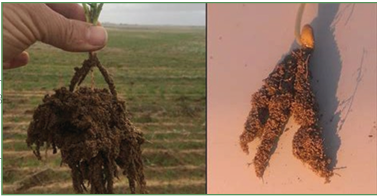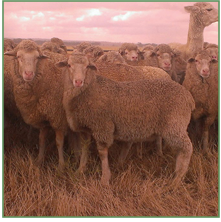Natural Intelligence Farming Editor’s Note:
I first met Ian and Dianne Haggerty in February of 2019 when we were all speaking at the Paicines Ranch. After hearing their story and seeing what they are doing on their farm, and the stunning results that they are seeing, I knew that I wanted to share it with other people. The Haggertys also spoke at the 2020 No-till on the Plains conference to share their information. – Keith Berns
“Facilitate positive global change by rebuilding soils in semi-arid regions, producing premium food and fiber, and supporting the nutritional needs of humanity to optimize health.” Big and bold words, but this is the passion of Ian and Dianne Haggerty who are doing just this on nearly 50,000 acres in the arid regions of Western Australia.
This has not always been their focus, but it grew out of frustrations and failures. After years of traditional farming, the Haggertys realized that they were subject to drought and rising input costs, and poor fertilizer performance. Much of the little moisture they received was lost to evaporation, and hardpans in their soils were severely restricting root growth. Ian Haggerty recalls, “It didn’t take long for us to realize that moisture in the soil was key to profitability and that hanging onto that moisture was critical to making a viable crop out of a poor spring. This fact, along with a questioning mind and noticing that there were discrepancies between soil test and tissue test results, sparked a drive for real answers. Reducing risk and increasing profitability year in and year out were key goals for the business to progress.”
So, Ian and Di started to research biologically-based farming systems with the aim of increasing their soil’s moisture holding capacity and microbial populations. Together they climbed up a steep learning curve and integrated some of the world’s top biological knowledge. They recall their educational experiences: “Dr. Elaine Ingham’s message of the miracle work of soil microbiological communities in providing optimum balanced nutrition to plants and prevention of disease and insect attack through soil health resonated with us. At the same time, we consulted with Jane Slattery of South Australia to develop an understanding of ruminant nutrition and interconnectedness with landscape health. Working on both the soil and animal health aspects concurrently enabled some wonderful synergies to express and assist with fast tracking the ecological progress of the farm. We were privileged to be introduced to Dr. Christine Jones, Dr. Maarten Stapper, and Walter Jehne, who had considerable knowledge on working soil health principles in Australian agricultural environments. Dr. Jones’ ‘liquid carbon pathway’ answered many questions of what was happening within the soil to improve its friability and moisture holding capacity. This was confirmed with deep soil carbon testing in 2012 that showed our soil carbon increased by 41% compared to neighboring soil in the top 30 cm.
“Natural Intelligence Farming” is the term the Haggertys use to describe their system that harnesses the dynamic, natural relationships that exist between the soil, the plants, and the biology in the farming ecosystem. These complex relationships involve mutually beneficial interactions between the soil, plant seeds and roots, microorganisms, and ruminants that feed on the plants and cycle dung and microbes back to the soil. The key to their success and natural intelligence farming is to not hinder or obstruct the interactions that support and inform these relationships—in other words, to work with nature and not against her!
The Haggertys believe that their agricultural methods can make a significant contribution to improving global trends in environmental management and human health. There is an existing and growing body of scientific research supporting a wide range of benefits associated with these farming methods, including:
- Carbon sequestration while producing optimal food and fiber.
- Increased biodiversity, particularly microbiological biodiversity in soil.
- Zero chemical residues tested in grains grown.
- Nutritional diversity and balance in foods grown.
- Elimination of synthetic fertilizers.
- Increased diversity in the microbiome.
- Return of diverse native plants throughout the farming landscape.
- Production of fully pasture fed meat that is high in Omega-3, conjugated linoleic acid, vitamin E, and has greater mineral diversity.
- Greater reliability in grain crop yields.
- Crop disease resistance resulting in decreased fungicides and pesticides.
Cropping Seeds are microbiologically coated before being directly seeded into a seed trench that is supplemented with natural fertilizers based on high grade worm liquid and compost extract. This ensures that the plant is biologically supported from germination to early growth. By supporting and encouraging the soil/plant root microbiome, the plant’s immune system is strengthened so that no fungicides or pesticides are necessary. By not using water soluble fertilizers with the seed, extensive root system growth is stimulated, and the plant is able to reach wider and more deeply for moisture and nutrition. The thick rhizosheath on the roots enables the crops to penetrate acid subsoil and enable positive regeneration. These roots and associated microbiology hold the soils together, improving soil structure, air and water penetration. The improved soil carbon levels then enable this water to be retained in the soil for longer periods along with nutrients to be available for plant growth. Crop quality is checked by periodic testing of tissue nutrient levels, which the Haggertys find more reliable than soil testing.
 Grazing Once grain is harvested, the stubble of the crop grown in this high microbial environment provides nutritious grazing fodder for their Merino sheep. Enhanced microbial activity in the soil, and the use of specially-bred sheep as the “farm machinery” has improved soil function, structure, and water-holding capacity and continues to value-add to the productivity of the landscape. In due course, remnant stubble is trampled down and is digested by fungi to add to the organic carbon in the soil. The cycle is completed with the return of nutrients and microbes to the soil via the sheep manure and urine. The sheep thrive on cereal stubble and native shrubs and grasses as their rumen flora is totally adapted to maximizing nutrient extraction from roughage. The livestock do not receive any grain supplementation. “Our sheep have developed into hardy, efficient producers with minimal artificial support and highly adapted to our local environment. The cropping and hay production contribute to our production of premium wool and lamb, but the sheep are playing their part in fertilizing the land and working the soil for us. Enhancing animal health and soil health conjointly facilitates a positive epigenetic spiral in this agricultural ecosystem,” reflects Di Haggerty. Ian and Di are confident that their products are superior to those produced by conventional agriculture using chemical fertilizers, pesticides, and fungicides. They go on to say, “We can consistently demonstrate that our produce, be it grain, meat, or fiber, is free from these chemicals. We also believe that our produce has greater nutritional and microbial diversity. We have established that there is a market for produce that can demonstrate sound ecological rejuvenation, high animal, plant, soil health outcomes and ultimately human health outcomes.” A growing number of consumers are seeking such products as the awareness of how purchasing decisions can influence planetary health is increasing. True ecological value is beginning to be factored into the market place creating a niche similar to organic.
Grazing Once grain is harvested, the stubble of the crop grown in this high microbial environment provides nutritious grazing fodder for their Merino sheep. Enhanced microbial activity in the soil, and the use of specially-bred sheep as the “farm machinery” has improved soil function, structure, and water-holding capacity and continues to value-add to the productivity of the landscape. In due course, remnant stubble is trampled down and is digested by fungi to add to the organic carbon in the soil. The cycle is completed with the return of nutrients and microbes to the soil via the sheep manure and urine. The sheep thrive on cereal stubble and native shrubs and grasses as their rumen flora is totally adapted to maximizing nutrient extraction from roughage. The livestock do not receive any grain supplementation. “Our sheep have developed into hardy, efficient producers with minimal artificial support and highly adapted to our local environment. The cropping and hay production contribute to our production of premium wool and lamb, but the sheep are playing their part in fertilizing the land and working the soil for us. Enhancing animal health and soil health conjointly facilitates a positive epigenetic spiral in this agricultural ecosystem,” reflects Di Haggerty. Ian and Di are confident that their products are superior to those produced by conventional agriculture using chemical fertilizers, pesticides, and fungicides. They go on to say, “We can consistently demonstrate that our produce, be it grain, meat, or fiber, is free from these chemicals. We also believe that our produce has greater nutritional and microbial diversity. We have established that there is a market for produce that can demonstrate sound ecological rejuvenation, high animal, plant, soil health outcomes and ultimately human health outcomes.” A growing number of consumers are seeking such products as the awareness of how purchasing decisions can influence planetary health is increasing. True ecological value is beginning to be factored into the market place creating a niche similar to organic.
 As with any growing enterprise, there are obstacles. The Haggertys have limited infrastructure and capacity to segregate their products in the logistic chain that transports the produce from the farm to the consumer. They are pursuing solutions as they believe that the value of identity preserved products will justify the required infrastructure investments. An exciting relationship has evolved with an artisan flour miller/baker in Perth who is sourcing grain from the Haggerty farm to supply flour, sourdough bread, and various pastries to customers and restaurants.
As with any growing enterprise, there are obstacles. The Haggertys have limited infrastructure and capacity to segregate their products in the logistic chain that transports the produce from the farm to the consumer. They are pursuing solutions as they believe that the value of identity preserved products will justify the required infrastructure investments. An exciting relationship has evolved with an artisan flour miller/baker in Perth who is sourcing grain from the Haggerty farm to supply flour, sourdough bread, and various pastries to customers and restaurants.
Future Goals Ian and Dianne plan to continue to expand and demonstrate the power of natural intelligence agriculture, while also helping other farmers do the same. They are working to establish the logistic chain for a segregated market initially for grain, meat, and wool and also are developing partnership ventures to add value to their products. They also hope to reintegrate indigenous culture and knowledge of land management, bush foods, and medicines. An on-farm research and education center to allow people to see, dig, taste, and experience natural intelligence food where they are produced is also a planned venture.

Ian and Di Haggerty